The Christmas holidays in Puerto Rico are a time to be enjoyed with your family and friends. After being away from them for many months, sharing the joy and love will be great mainly around a table rich of Puerto Rican Christmas food.
Many Puerto Ricans have a tradition of eating different foods for traditional dishes usually only eaten during this holiday season. The main ingredients in these foods are yautias, malanga, and sweet potatoes.
They can be fresh at local food markets or farmers’ markets during November and December. They are already cleaned and peeled, making it very easy to make your delicious dishes.
Below are the Top 10 Christmas Foods in Puerto Rico, and prepare them.
1. Tembleque
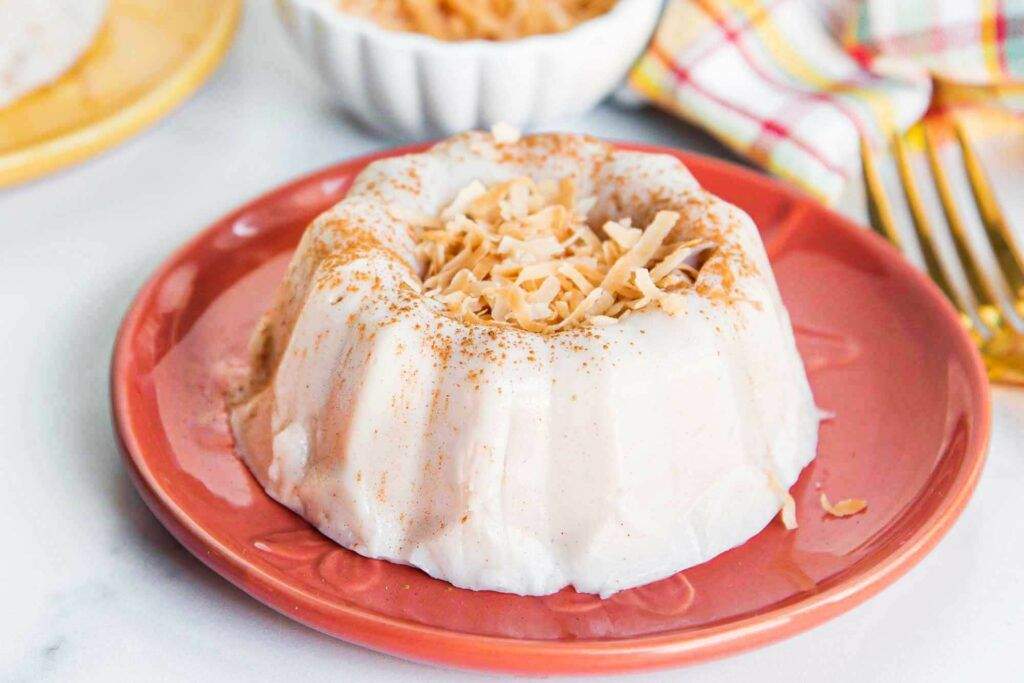
Tembleque is a dessert made of coconut pudding with a smooth texture similar to flan. It is typically prepared in a decorative mould and served on a platter, and, just like Arroz con dulce, it is topped with cinnamon. The delicious dish can be prepared in cups for quick single servings. Try the tembleque, and you’ll be able to create the perfect Christmas treat.
Ingredients
2 (14 ounce) cans coconut milk
¾ cup sugar
¼ teaspoon kosher salt
½ cup cornstarch
1 pinch ground cinnamon
Cooking Directions
Step 1
Mix the coconut milk mixture, sugar, and salt in a pan. Pour a couple of tablespoons of the mixture of coconut milk into a small bowl. Then stir the cornstarch mixture until it dissolves; then pour into the pan. Let the mix come to a simmer, stirring continuously to cook until the mixture is smooth and thick, around 5 minutes.
Step 2
Put the mixture of coconut milk into molds. Cover each mold with plastic wrap and then refrigerate until it is firm and cold for 3 to two days.
Step 3
Use a knife to cut all the sides of your mold, then turn it upside down onto a plate to get rid of it. Sprinkle tops with cinnamon.
2. Arroz con dulce
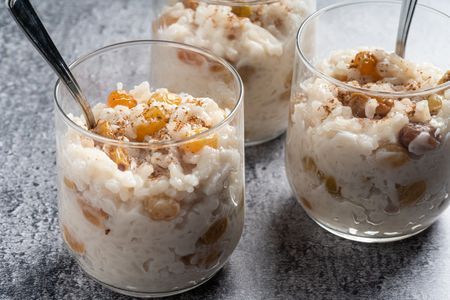
Christmas isn’t complete without sweets, so the Arroz con dulce is a perfect choice. The sweet rice pudding is made from coconut milk and spices that reference the Christmas season, such as cinnamon, nutmeg, ginger, and cloves. Raisins are usually added to the top of the dish, along with additional grounded cinnamon and cinnamon sticks to add flavour and garnish.
Ingredients
1 cup rice
Two teaspoons salt, or to taste
1 teaspoon dried oregano
½ teaspoon ground black pepper
1 bay leaf
2 cups chicken stock, or as needed to cover
1 cup green peas
½ cup sliced black olives
½ cup raisins
¼ cup chopped pimento peppers
¼ cup vegetable oil
1 (4 to 6 pound) whole chicken, cut into pieces
1 onion, chopped
One green bell pepper, chopped
Two cloves garlic, minced
Two cloves garlic
1 (14.5 ounces) can stewed tomatoes
Cooking Directions
Instructions Checklist
Step 1
Preheat oven at 350 degrees F (175 degree C).
Step 2
Cook vegetable oil in the Dutch oven on medium heat. Cook and stir the chicken until golden brown for five to ten minutes. Remove the chicken using the help of a spoon slotted in and set on a platter. Stir and cook onion and green bell peppers, minced garlic, and whole cloves of garlic inside the Dutch oven until the onion has softened, which takes about 5 minutes.
Step 3
Return the chicken to the onion mixture. Add rice, tomatoes, salt, oregano, salt, black pepper, bay leaf. Add enough chicken broth to cover all of the ingredients.
Step 4
Bake the chicken-rice mix in the oven that has been preheated until the rice is cooked through and the chicken no longer pink in its center, and the juices run precisely, approximately one hour, thirty minutes. A thermometer that is instant-read placed near the bone should be reading the temperature as 165° F (74 degrees Celsius).
Step 5
The chicken rice mixture combines olives, peas, pimento peppers, and raisins. Bake until warm through about 15 minutes more.
03. Ensalada de coditos o papas
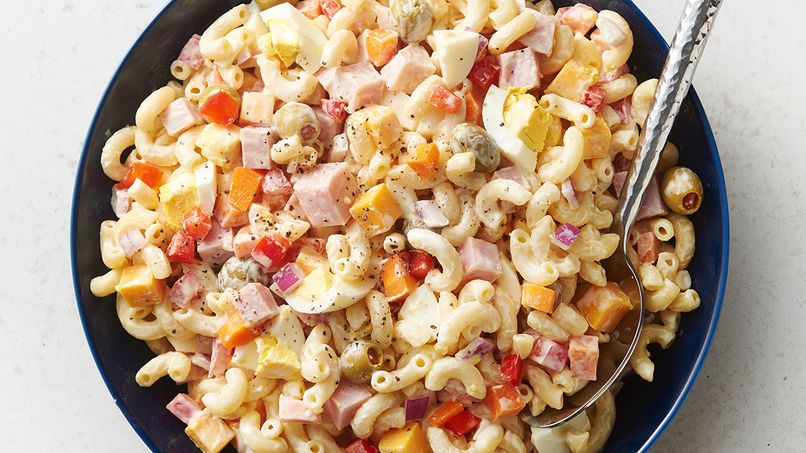
Although macaroni salad and potato salad may not be very unique, it’s the norm at all in Puerto Rico without them. The macaroni salad can be a meal in and of itself with chopped ham and hardboiled eggs and chunks of cheese to add. The potato salad recipes are endless and include surprises such as chopped red apples and green peas shelled.
Ingredients
1 lb cooked macaroni pasta
Salt and pepper, to taste
2 cups cooked ham
1 cup cheddar cheese, diced
1 carrot, diced
One small red onion, chopped
1/2 cup olives
Five hardboiled eggs, chopped
Mayonnaise, as desired
Two teaspoons heavy cream
1 red bell pepper, diced
Cooking Process
Step 1
Prepare the pasta according to instructions on the package with a touch of salt. When the pasta is cooked, drain it well and place it aside.
Step 2
Mix the pasta in with the remaining ingredients. Mix the ingredients, diluting the mayonnaise by adding two tablespoons of cream before adding.
Step 3
Mix again and garnish with a few slices from red bell pepper and hardboiled eggs.
04. Guineitos en escabeche
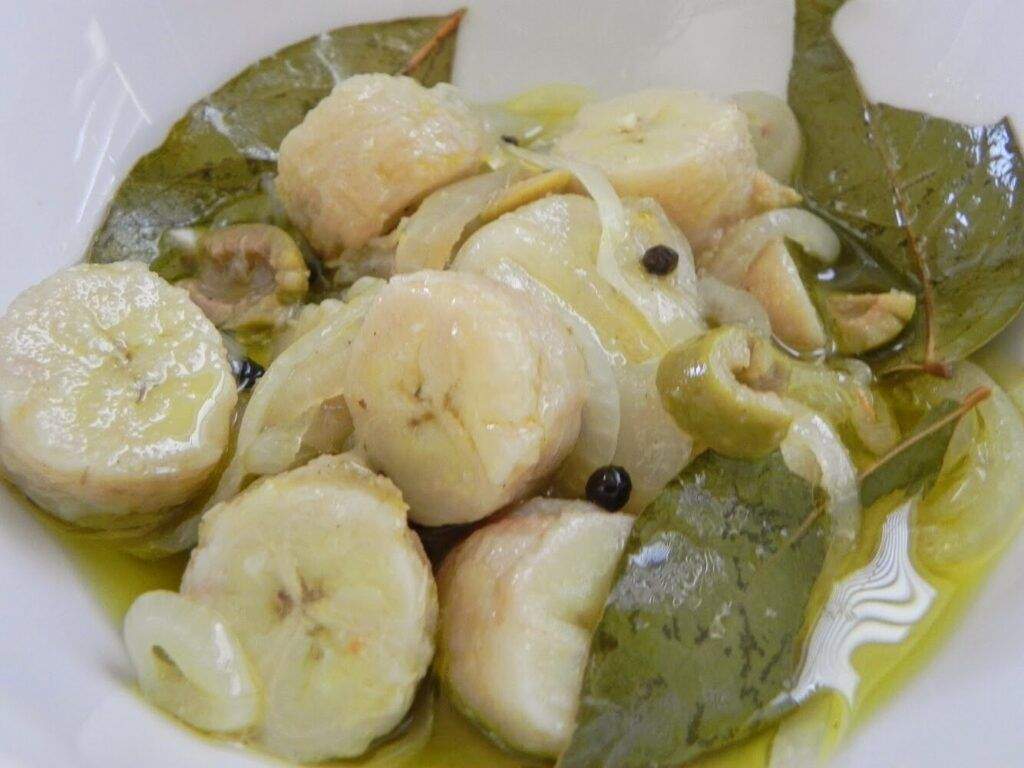
Holiday meals require accompaniments and the guineitos in escabeche spinach salad is a delicious flavour of Puerto Rico. The Guineitos are cooked in a marinade consisting of white vinegar, chopped onions, garlic cloves, olives green, peppercorns, salt, bay leaves, olive oil, and bay leaves chilled. The vinegary tang from green banana salad pairs well with pernil, Lechon and pernil.
Ingredients
- Seven green bananas
- Two onions, chopped and cut into slices
- Six bay leaves
- 1/2 1 tbsp whole black pepper
- Four cloves of garlic, minced
- 2 1/2 tablespoons salad olives. My favorite is Goya
- 1 1/2 cup olive oil
- 1 cup white vinegar 1 cup white
- 1 tsp or until you are satisfied salt
- One teaspoon or until you are satisfied with the taste, Adobo is my favorite. Goya
Cooking Instructions
- Peel the bananas, then make a big dish with water and salt.
- Put the bananas into the water, and allow them to boil for 20 minutes at least until they’re soft enough to allow one to put a fork into them but not too soft that the bananas break apart. Inspect the bananas after 15 minutes to ensure that it is not the case.
- Mix the chopped onions with vinegar, olive oil, bay leaves, black pepper, corns, garlic, salad olives, and “adobo” or salt in a small saucepan when the boiling bananas have finished.
- Let them sit at a medium/low temperature so that the mix is warm but not boil for 10to 15 minutes. It must remain warm, and the onions soften slightly.
- If you use a full glass of vinegar, the flavour will be tangier and brinier. I love the tangy taste; however, try half a cup of vinegar if you’re not sure. Add more once you have tasted it to see if you like it.
- Once the bananas are finished boiling, drain the water and then cut them into pieces of 1/2 inch.
- Set them inside a glass bowl, and pour the warm-up “escabeche” over them.
- Keep them in the refrigerator for a minimum of at least a few hours. The longer you let them marinate in the fridge, the better they taste.
- Serve at room temperature for an appetizer or as an accompaniment.
05. Guanime
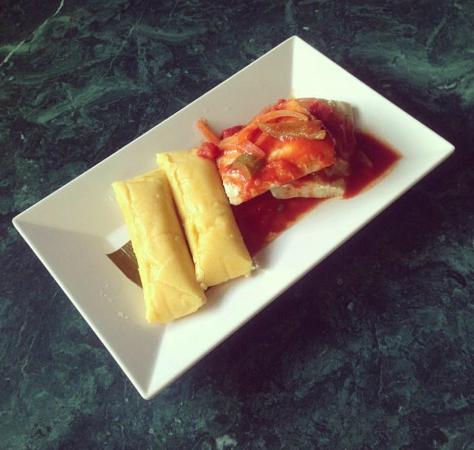
In the past, pasteles were Guanime dating to the Taino. The masa is made from wheat or corn flour instead of various fruits and root vegetables. Guanime can be prepared using only masa and are sweet or savoury. Guanime is also packed in banana leaf and then boiled.
Ingredients
For the Filling
- 1 Lb ground beef
- 1 cup tomato sauce
- One bell pepper cut into pieces.
- One scotch bonnet, pepper with no seeds, and chopped
- 1 . Small onion chopped
- Two cloves garlic
- 1 sprig parsley
- 1 sprig recao/cilantro or ancho/culantro
- 1 1/2 teaspoon salt
- 1/4 tsp of pepper
- 3 tbsp olive oil
For the Cornmeal
- 3 cups cornmeal
- 5 cups of vegetable soup at room temperature
For the Guanimes
- 16 corn husks, or an equivalent amount of parchment papers
- cotton string
- Two qts water
Instructions
Making the Filling
· Make use of the food processor to create a paste from bell pepper, Scotch Bonnet garlic, onion parsley, cilantro ancho, as well as salt, pepper, and
· Add seasoning paste to the ground hamburger. Mix until it is evenly mixed.
· Brown the hamburger at moderate temperature. Stir and cook until the is cooked thoroughly.
· After the meat has been cooked, cook the sauce with tomatoes. Stir and cook until the sauce has evaporated. Add salt as needed.
· Remove the pan from the oven and put it aside.
Make the Cornmeal
· Mix the cornmeal and broth and allow it to rest covered for one hour.
· Cook the cornmeal and broth at medium temperature, frequently stirring until thicker. Lower the heat, and stir it until the broth becomes thick enough to adhere to the spoon.
· The cornmeal will not be thoroughly cooked, and however, it will be ready in the future. Take it off the heat and let it cool to the temperature of a room.
Assemble the Guanimes
· Put two tablespoons of cornmeal in a corn husk, and flatten. Fill with one tablespoon filling. Over it by two cups of cornmeal.
· Create an envelope shape and then cover the envelope with cornhusks or cornhusks until the envelope is water-proof. String it up. Refer to the for more details.
· 2.25 Qt of water on high temperatures in a large pan until it reaches a boiling point. After the water has reached a boil, put the cornmeal dumplings inside the pot, and allow them to boil for 10 minutes.
· Serve: Remove the husks and water and serve. Serve with ketchup.
06. Pasteles
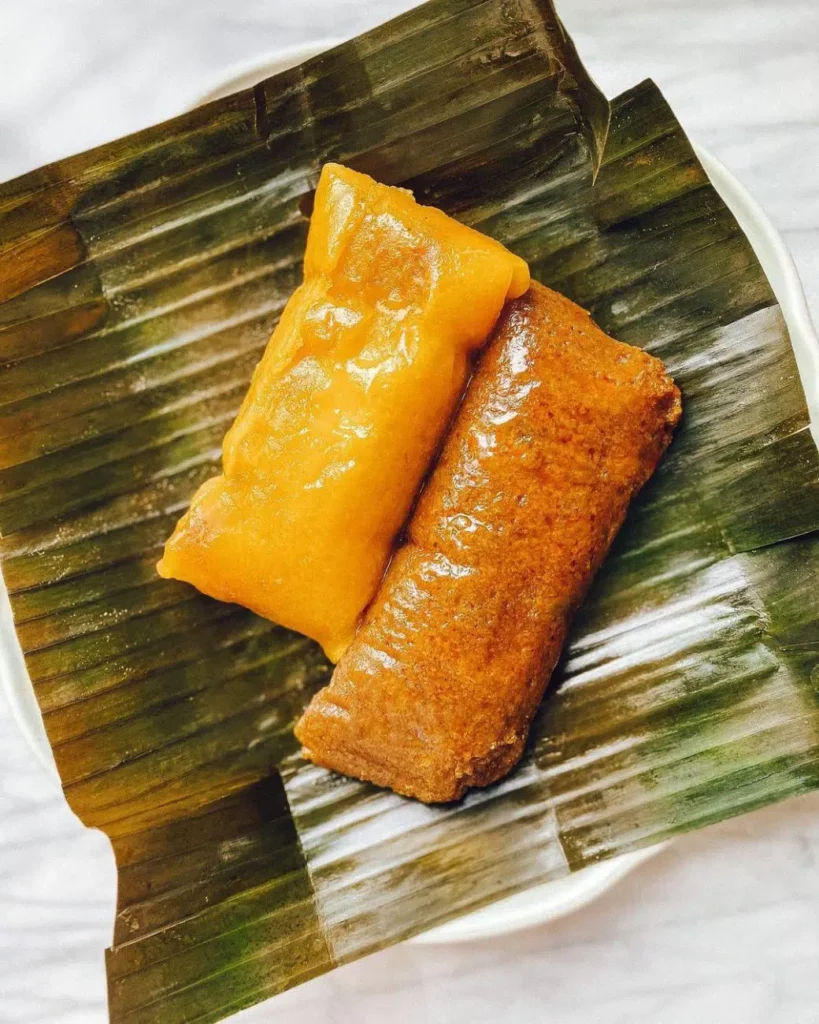
The holidays are about spending time with loved ones and friends, and a day of making pasteles is a great way to do the job. The secret to making pasteles is masa. It’s which is the “dough” that is used. Masa is made of plantains that are green, bananas, and the yautia (taro root), as well as potatoes and pumpkin. Small chunks of masa are combined with water or broth through a food processor and ground into a mash or paste.
A few families have designed their kitchen appliances for grinding masa! Pasteles come with a flavorful filling that is usually chicken or pork. However, the options are as endless as your culinary imagination. It is also possible to add delicious sweets like chickpeas, raisins, or raisins. When the masa and filling are made, the hard task begins assembling or wrapping them. Start by laying a piece of parchment paper on your work surface. Spread a tiny amount of achiote oil into the center of the paper. Next, place a banana leaf over the parchment paper. Spread a small amount of achiote oil, and then spread a rectangle of the masa. On the masa’s top, add a couple of tablespoons of the filling.
It’s the time for you to tie your pasteles, is a sequence of tucks and folds. The two pastels are then connected by a string, with their seams pointing towards each other. They should be tightly wrapped so that no water can get into them while boiling. This is a fairly simple process that is why families and friends can make it a fun day.
Ingredients
2 pounds of yuca peeled and finely chopped
2 pounds of green plantains Peeled and chopped coarsely
2 pounds of yautia, chopped coarsely and peeled
2 cups milk
1 pound lard
1 2 lbs Achiote seeds
One cup olive oil or according to your preference.
1 onion chopped
One bell pepper with a green color chopped
2 pounds of pork shoulder roast Cut into small cubes
1 pound of ham chopped into cubes
2 cups garbanzo beans
2 (8 8 ounces) cans of tomato sauce
1 (5 ounces) jar pitted Spanish olives
1 (4 ounces) jar capers
Three tablespoons of orange juice
Four sprigs of cilantro, chopped
Two teaspoons dry oregano
1 tablespoon salt
Two cloves garlic, minced
24 leaves of plantain
kitchen string
Directions
Instructions Checklist
Step 1
Mix yuca, green plantains, yautia, and milk in a blender. Blend to form a thick paste that resembles oatmeal.
Step 2
Combine achiote seeds and lard in a pan over moderate heat. Heat until the lard has melted and the color is reddish, around 5 minutes. Separate the achiote seeds. Mix half of the lard with this yuca paste.
Step 3
Add the onion and green bell pepper to an enormous pot at medium-high temperature. Cook in a stir-fry until they are tender, around 5 minutes. Add pork and ham, garbanzo beans, tomato sauce, olives and capers, and orange juice, as well as oregano, cilantro, salt, and garlic; cook and stir until pork is no pinker in the middle, about 8 to 10 minutes. Take off the flame.
Step 4
Mix the remaining lard in the pork mixture.
Step 5
Make sure to smear each leaf with a tiny amount of remaining lard. Add a heaping portion of the mixture in the middle of each leaf and top it with one portion of the pork mixture. Fold the edges of each leaf to cover the contents and form an oval pastel.
Step 6
Two pasteles should be stacked and tied together using kitchen string. Repeat with the remaining pasteles.
Step 7
Make a large container of water up to the point of boiling. Add pasteles. Cook until the filling is soft, approximately 1 hour. Remove the wrapper before serving.
07. Cuajito

The Puerto Ricans also use the stomach of a porcine for a delicious food known as cuajito. The pig’s stomach is soaked in vinegar and water washed and rinsed. It is then simmered to a salty temperature until soft. The tomato sauce is then made with the cuajito, and then the final cuajito is then added. Don’t be afraid to take a bite of this since it’s a cozy warm food you’ll want to enjoy throughout the year.
Ingredients
Cuajo
1 pounds of Cuajo
5 cloves of garlic
3 1/2 teaspoons salt
4-5 culantro leaves
One onion (small)
3 Tablespoons of Vinegar
6- 8 cups of water
Sauce
1.5 cups chicken broth
3-4 tablespoons of margarine , or butter
Four 1/2 teaspoons flour
3/4 cup tomato sauce
3/4 teaspoon onion powder
Salt to taste
The hot sauce can be flavored to suit your taste (optional)
Directions
Cuajo
Take the fat off the cuajo. Cut it into tiny pieces and wash thoroughly.
In a 1-quart pot of water, Add the vinegar, add the cuajito to the water and let them soak for 15 to 20 minutes.
After you have soaked, strain the cuajito and then rinse it well.
In a large pot, put in the salt, water, and cuajito.
Bring it to a boil at a high temperature. Once it starts to foam, take it from the heat and mix in the cilantro leaves and the onions and garlic cloves. Make sure to cover your pot.
Reduce the heat to medium, and cook for approximately one hour, 45 minutes, or until the cuajito becomes very soft.
Let it drain and cool to room temperature while you prepare the sauce.
Sauce
Put the chicken broth and the tomato sauce into the pot and let it simmer.
As the tomato sauce simmer, melt the margarine butter on a low flame and incorporate the flour. Blend it thoroughly.
Add onion powder and salt. Mix thoroughly.
Incorporate the hot broth along with tomato sauce. The heat should be increased to medium-high and cook for 8 to 10 minutes. Stir often.
Add the cuajito. Continue to cook for five more minutes.
08. Pernil

If you love the pork product, Puerto Rico is the ideal trip for you for Christmas. Another popular Christmas meal is pernil (pork leg or shoulder of pork) cooked with a paste consisting of garlic, olive oil, oregano, salt, and vinegar and then marinated for up to 3 hours to two days or longer, and later, it is slow-roasted. To ensure that nothing is wasted, the skin of pernil is removed and fried before being eaten as chips called Cuero.
Ingredients
1/4 cup olive oil
Three tablespoons of white vinegar
Ten cloves garlic or more if you like.
Two tablespoons of dried oregano
1 tablespoon salt
1 1/4 teaspoons of ground black
5 pounds of pork shoulder cut off excess fat
Directions
Instructions Checklist
Step 1
Mix vinegar, olive oil, garlic, oregano, black pepper, and salt in a mortar and pestle. Smash into a fine paste.
Step 2
Make slits deep into the pork using the help of a small knife. Fill the slits with the paste and rub any leftover paste on the pork.
Step 3
Place the pork in a roasting bag, then place it into a roasting pan with a rack. Then let it marinate in the fridge for up to 8 hours.
Step 4
Take the pork out of the refrigerator, open it up and allow it to come to the temperature of the room, about within 1 to 2 hours.
Step 5
Preheat oven at 300 degrees F (150 degrees Celsius).
Step 6
Skin-side down, roast the pork in the preheated oven until golden, approximately 2 hours. Then flip the pork and continue roasting with the skin side up until the juices run clear, with an instant-read thermometer placed into the middle registers at a minimum of 145 degrees F (63 degrees Celsius) 2 to 4 hours.
9. Longaniza

Another traditional Christmas dish included on the sausage plate is longaniza. The morcilla pork is ground, while the meat in longaniza is chopped into pieces. Annatto, made from an achiote’s seed tree, gives the sausage its brick red hue and adds a nutmeg flavour. Garlic, oregano and salt, and pepper are usually included. Longaniza is usually served in a fryer or grill, and it is often added to rice and is served as a meal with a side dish—Arroz with longaniza.
Ingredients
1 kg chopped pork (30 percent fat)
1 cup of brown sugar
1 1/2 2 tbsp salt
2 tbsp cane vinegar
3 tbsp soy sauce
1 entire garlic chopped
2 tsps black pepper powder
2 tsp of annatto powder
sausage casing
Instructions
Put all remaining ingredients in a large mixing bowl, mix vinegar, soy sauce, and Annatto powder and mix.
The mixture should be placed in the sausage stuffer, then placed on the other side, and tie a secure knot around the other end. Fill the sausage casing with meat mixture, alternating every 2 1/2 inches twist until you have a sealed section. Gently pack each section until completed with all the meat.
Once it is in the casing, put it in the refrigerator for at least a day to dry, then hold its form and allow it to soak in the spices. Put it in the freezer to store.
To cook, place the sausages in a pan, then add some water and cook at a low temperature while being covered. When the water is dry, add oil, and cook it slowly until the sugar begins to melt.
10. Morcilla
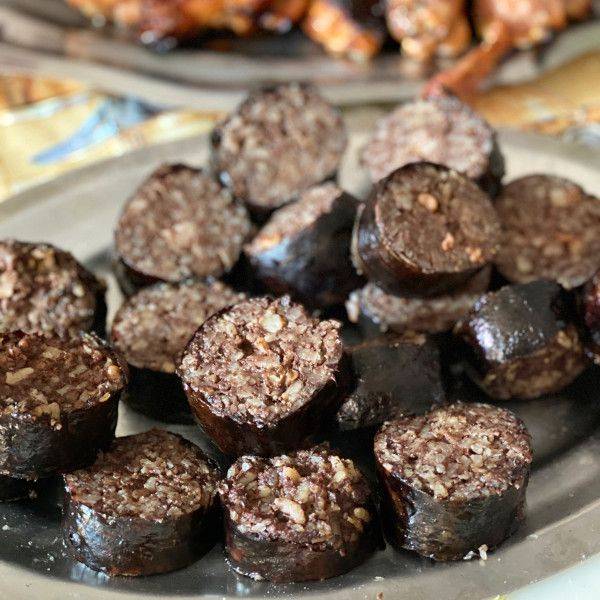
Commonly served with Lechon is the morcilla (blood sausage). Like Lechon, it’s served all year long but is particularly popular during holiday celebrations. Morcilla is made from ground pork and blood from pork and is then seasoned with rice and other spices such as garlic, cilantro and salt. Chilli peppers are also added to boost the spice.
Ingredients
A quarter cup of duck fat Lard
Two cups of minced sweet onions (about two medium onions)
Ten cloves of garlic, minced
Two tablespoons Spanish paprika
One teaspoon of kosher salt
One teaspoon of ground cloves
4 cups of cooked white long-grain rice (preferably an entire day-old)
1 pound of pork belly, cut and cut into 1/8-to 1/4-inch cubes
6 cups of bloody pork that has been strained
12 ft. hog casings
One tablespoon olive oil one tablespoon olive
Directions
Instructions Checklist
Step 1
Pour the duck fat into an iron skillet on medium-high. Add the garlic and onions, cooking, and frequently stirring until caramelized slightly about 8 to 10 minutes. Reduce the heat to medium-low. Add salt, paprika, clove and cook. Stire frequently until rust color has disappeared and tender, about 8 to 10 minutes. Remove the skillet from the heat and allow it to cool completely, approximately 20 minutes.
Step 2
Mix the onion mixture with rice along with pork belly into one bowl. Pour the pork’s blood over the pork belly, then stir until it is well-combined.
Step 3
Cut casings into six (2-foot-long) segments. Then, run water across each segment, ensuring there aren’t any holes or tangles. Make a knot at one the end of each section of casing. Attach the opposite side to the funnel’s spout (at least 1/4-inch diameter). Divide the pork belly mixture into six equal portions. Pour one portion of the pork mixture into a funnel. Use the wooden spoon handle to pour the pork belly mixture into the casing, making sure that it passes through the spout to the casing. Repeat the process for the rest of the casing and leftover pork belly mixture.
Step 4
In a large saucepan, bring water to a simmer at 160 degrees. (It is vital to maintain an ambient temperature of 160degF. It is not safe to cook if the temperature is higher than 170 degrees and the blood curdles. as it cooks.) Make sure to add the sausages to the water in small batches, if needed and cook without disturbing 15 minutes. Remove sausages and make a spiral on a large platter baking sheet, and then refrigerate covered for up to 8 hours, or overnight, to be set.
Step 5
Slice the sausages crosswise into 1/2-inch thick rounds. In a cast-iron or nonstick skillet at medium-high. Add sausages and cook until they are browned and warm, approximately 3 minutes on each side.
Step 6
Notice: You could also grill the whole links on medium-high heat, then cut them to serve.
11. Lechon
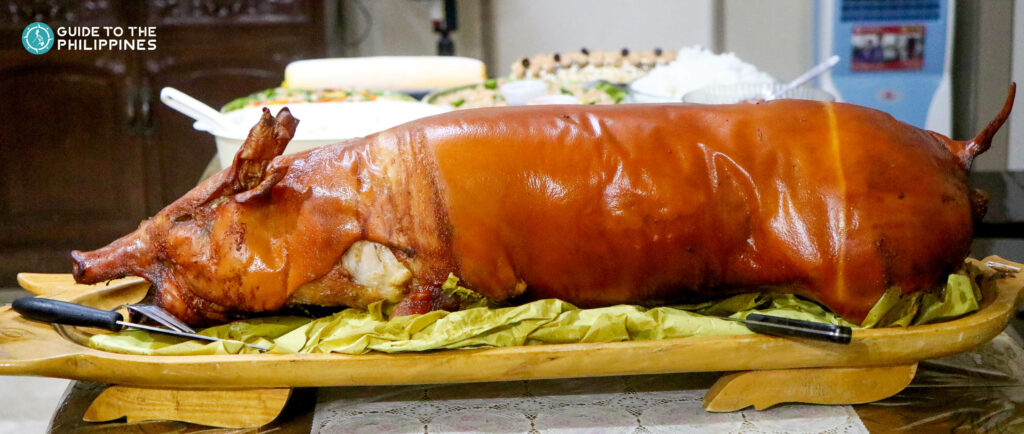
No matter if you’re visiting Le Ruta de Lechon (The Pork Highway) or find an eatery that hosts their roast of pigs, Lechon is a popular dish all year round – however, Christmas is not complete without Lechon.
The name derives from the word Leche, which means milk because the suckling pigs were used in the past. However, as the popularity and appetite increased, so did the size of the porks.
At first, they were was known as Lechon en la Varita because of the “wand” or spit used for cooking. Most lechoneras today utilize spits made of metal over open fires or cooked using metal roasters. Slow roasting produces a succulent and tender delight often served with Arroz con-gandules, mamposteao or yuca salad.
Ingredients
- One tablespoon of whole black pepper
- 1 tablespoon cumin
- 1 tablespoon of oregano
- 1 bay leaf Crushed
- Two tablespoons of salt from kosher.
- 1 Tablespoon garlic powder
- 1/2 teaspoon cayenne
- Five large cloves of garlic, mashed
- 1/4 cup sour orange juice
- 1/3 cup olive oil
- Three to four pounds bone-in pork butt, or shoulder with the skin or a good layer of fat
Instructions
- Mix the cumin, black pepper, oregano, black pepper, and bay leaf. Blend to a fine powder using the spice mill. In a small bowl, mix the spice mixture, including salt, garlic powder, and cayenne. Add the garlic cloves mashed along with sour orange juice and olive oil until you’ve created an extremely loose paste. Wrap the pork in the paste and put it in the glass bowl or other non-reactive container. Refrigerate for at least a night.
- The next day you can pull the pork from the refrigerator and let it cool to the room’s temperature while you heat your oven until it reaches 325 degF.
- Place the pork in the roasting pan, then place inside the oven. The pork should cook until the meat’s temperature reaches 160 degF (about 40 minutes for each pound).
- Remove the roast out of the oven, and cover it with foil. It should sit for 10 minutes before cutting. Serve it with beans and rice or cut it thinly and place it in sandwiches.



5 Comments
Pingback: Top 5 Best clubs in Puerto Rico - Knowing Puerto Rico
Pingback: Puerto Rican Food: Your Daily Food - Knowing Puerto Rico
Pingback: Foods from Puerto Rico That you should Try When you Visit - Knowing Puerto Rico
Pingback: Top 10 Museums in Puerto Rico - Dive into our art and history
Pingback: Do You Need A Passport To Visit Puerto Rico?